3 Types of Residential Solar Electric Power Systems
There are three main types of residential solar electric power systems: grid inter-tied; grid inter-tied with battery backup; and off-grid. These three broad types vary in how closely connected they are to the traditional power utility infrastructure, known as the grid. Each type has strengths that determine how suited they are to your needs.
Grid Inter-Tied Residential Solar Power Systems
A grid inter-tied solar power system is directly connected to the home and to the traditional electric utility grid. Grid inter-tied systems allow the homeowners to get power from either the home electric system or the utility grid. Switching between the residential system and the grid is seamless.
The prime advantage of this type of system is the ability to balance the system production and home power requirements. When a grid inter-tied system is producing more power than the home is consuming, the excess can be sold back to the utility in a practice known as net metering. When the system is not producing sufficient power, the home can draw power from the utility grid.
Grid inter-tied systems are the lowest cost type of residential solar electric system, due to having fewer required components.
Grid Inter-tied Residential Solar Power System with Battery Backup
A grid inter-tied solar power system is also connected to the traditional utility power grid and adds battery-backup to the system. The addition of a battery backup enables the system to balance production and demand and protects against power outages.
Solar electric system production depends on the available sunlight. When sunlight is abundant, production can exceed demand. When production exceeds demand, the excess power can charge the batteries, which store the electricity. When the system is producing less electricity than demanded by the home, the batteries can make up the shortfall.
Grid Inter-tied systems are also connected to the utility power grid. This enables the homeowners to draw from the grid during periods of excess demand and to sell power to the grid when there is excess production.
While grid inter-tied systems offer more flexibility, they are not without disadvantages. Charging and discharging batteries reduces the overall efficiency of the system and these systems are more complex to design and install and therefore more expensive.
Off Grid Solar Power Systems
An off-grid residential system is completely disconnected from the traditional electric power grid. Without a connection to the utility grid, batteries are essential to balance periods of excess production and excess demand.
To protect against shortfalls of power when the solar system is under-producing and the batteries are discharged, an electric generator is usually added to the system. The generator is used as a power source during periods of prolonged excess production or unusual demand.
All Systems
Within each type of system there are subtle variations in design that effect efficiency and convenience. To determine which system is best for you, review your requirements with a solar installation professional. A professional installer can guide you through the detailed choices of specific systems that best match your needs.




